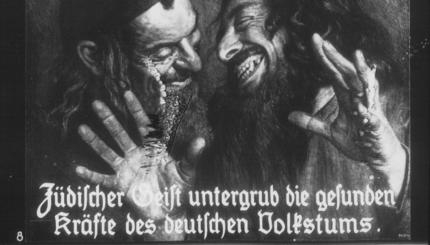It is daunting to think of the number of books a Jew “must” read in order to achieve Jewish literacy. With trepidation I suggest yet another volume to add to that list: the New Testament (NT).
Anyone who lives in a country with a Christian majority (such as the United States or Canada) should acquire basic knowledge of the foundational literature of the dominant faith. Students of the arts need to know stories like the prodigal son (Luke 15:11-32), the raising of Lazarus (John 11:1-44), and the “passion” of Jesus (i.e. his trial, suffering, and death) or they will be at a disadvantage when studying many works of literature, art, and music. But there are also reasons why Jews, specifically, would gain from study of the New Testament. It is a rich source for a better understanding of Jewish history, Jewish thought, Jewish law, and the history of anti-Semitism.
Almost all of the books of the NT were written by Jews, many of them during one of the most eventful periods of Jewish history: just before and just after the destruction of the Second Temple (in 70 C.E.). Very few Jewish writings from that century survive, and none by the rabbis, the representatives of what soon became normative Judaism, since the rabbis of that period felt that their teachings had to remain oral (a position they eventually abandoned). So really the only surviving religious books written by Jews in the first and second centuries are a few of the later Dead Sea Scrolls and the NT.
Ancient Jewish Sects
Any rabbinic text describing the factions and sects of Jews in Israel in the first century were written much later–only after groups like the Sadducees and the Essenes no longer existed. And while biblical critics teach us that most of the NT authors never actually saw Jesus–and so their descriptions of his words and actions are at best second-hand reports–these authors definitely did record their first-hand knowledge and experience of what it was like for a Jew to live in the Land of Israel in the first century, under the oppressive Roman occupation. They often described the old Jewish sects and the tensions between them in very realistic ways.
For example, the book of Acts (23:1-10) tells a surprising story about Paul, who realized he was in danger from a Jewish crowd because of his belief that Jesus had been resurrected and that faith in Jesus was the only way of achieving salvation. Paul figured out an ingenious way to escape their wrath:
“When Paul perceived that one part were Sadducees and the other Pharisees, he cried out in the council (verse 6), ‘Brethren, I am a Pharisee, a son of Pharisees; with respect to the hope and the resurrection of the dead, I am on trial’.” In other words, Paul convinced the crowd that all the opposition to him had originated from Sadducees–who did not believe in the concept of resurrection and who were angry that Paul was teaching that resurrection of the dead would occur. Once Paul made that claim, the book of Acts records that the Pharisees in the crowd rallied to Paul’s defense (“We find nothing wrong with this man”) and he successfully escaped the angry members of the crowd.
This text creates the impression that, in the first century, the followers of Jesus might have been very similar to the Pharisees–the faction that went on to become the dominant group of rabbinic Judaism. And there are many other texts in the NT that support this idea.
Familiar Language & Ideas
In fact, the more a modern Jewish reader is acquainted with rabbinic literature, the more he or she is likely to find texts of interest in the NT, and to notice just how similar many NT teachings are to those of the rabbis. For example, Jesus is quoted in Mark as coming to the defense of some of his disciples who had been criticized by the Pharisees for breaking the laws of the Sabbath. Jesus said that they had done no wrong since “The Sabbath was made for man, not man for the Sabbath” (Mark 2:27).
Some readers over the years have concluded that Jesus was making an antinomian statement, devaluing the Sabbath. But students of rabbinic literature will recognize that Jesus’ words sound very similar to those of Rabbi Yonatan b. Yosef in the Talmud, explaining why the Sabbath may be desecrated to save a human life (Yoma 85b): “‘It [= the Sabbath] is holy for you’ means that the Sabbath was handed over to you and you were not handed over to it.” This is not to say that Jesus and Rabbi Yonatan would necessarily agree about the criteria that justify breaking the Sabbath. But Jesus’ remarks appear much more orthodox when read beside those of Rabbi Yonatan.
Much of the Sermon on the Mount (Matthew 5-7) reads, on a rhetorical level, like an anti-rabbinic text. In it Jesus argues that the righteousness of “the Scribes and the Pharisees” (= the rabbis) is insufficient and he challenges his followers to strive for what he considered a higher level of morality. The “Lord’s prayer” (Matthew 6:9-13) is introduced by Jesus with a charge to his followers not to pray the way the hypocrites pray in synagogue.
But, in fact, every phrase in the prayer can be found in rabbinic literature. For example the opening phrase, “Our father who art in heaven” is simply the Hebrew phrase avinu she-ba-shamayim, found in the beginning of many rabbinic prayers. And the ethics of the Sermon on the Mount are, on most points, very similar to those of the rabbis. Books like The Jewish Sources of the Sermon on the Mount, by Gerald Friedlander, show just how many teachings of the NT, particularly those found in the synoptic gospels (Matthew, Mark, and Luke), are parallel and sometimes even identical to the teachings of the rabbis.
For example, Jesus claims in Matthew (19:9) that divorce is permitted only in a case of adultery and his position is presented there as being in stark opposition to that of the Pharisees. Students of Mishnah know that a great rabbi in the generation before Jesus said the same thing (the opinion of the house of Shamai in Gitin 9:10).
Both Jews and Christians ought to understand that most of Jesus’ reported teachings are, from a rabbinic perspective, not particularly revolutionary or even new, and that the rift between Judaism and Christianity is a function of what was said about Jesus after his death.
The Differences between Jews and Christians
Of course, that is not the whole story. Careful Jewish readers of the NT will come to a better understanding of the vast theological differences between Jews and Christians–for example, on the issue of whether God can have a son, and whether God can be incarnated in a human body. Jews will also find interest in reading the virulently anti-Jewish passages of the NT that have resonated in the minds of many Christians over the ages.
It is hard for a Jew not to be taken aback when reading Paul’s reaction upon hearing that a group of recent Christian converts were considering becoming circumcised. Paul castigates them: “If you receive circumcision, Christ will be of no advantage to you” (Galatians 5:2). And, for good measure, Paul expresses the hope that the (presumably Jewish) advocates of circumcision will let the knife slip and mutilate themselves (Galatians 5:11). While modern scholars have tried to contextualize and tone down the shocking words of Jesus to a group of Jews, “You are of your father the devil” (John 8:44), Jews should know about this and similar statements in the NT because throughout most of the last two millennia, many Christians did believe literally that the Jews were associated with the devil, their father.
Jews can read the NT to see both the strong Jewish values and the strong anti-Jewish values there. Virtually every page of the NT addresses Judaism either implicitly or explicitly. Jews who want to read a “Jewish book” will find much of interest there.



